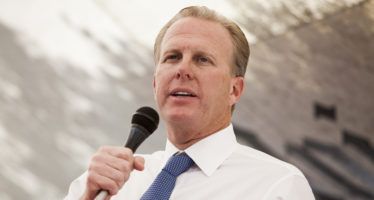Union appeal focuses attention on pension precedent
 SACRAMENTO – A decision by four Marin County public-employee associations to appeal a pension-related case to the California Supreme Court could ultimately determine whether localities have the tools needed to rein in escalating pension debt. At issue is how far officials can go to reduce some benefits for current employees after a state appeals court has chipped away at a legal “rule” long favored by the state’s unions.
SACRAMENTO – A decision by four Marin County public-employee associations to appeal a pension-related case to the California Supreme Court could ultimately determine whether localities have the tools needed to rein in escalating pension debt. At issue is how far officials can go to reduce some benefits for current employees after a state appeals court has chipped away at a legal “rule” long favored by the state’s unions.
In August, a California appeals court ruled against the Marin County Employees’ Association in its case challenging a 2012 state law reining in pension-spiking abuses – i.e., those various end-of-career enhancements (unused leave, bonuses, etc.) that public employees use to gin up their final salary and their lifetime retirement pay.
One of the few areas of widespread agreement at the Capitol on public-employee pensions involves spiking. Gov. Jerry Brown signed into law the Public Employees’ Pension Reform Act of 2013, known as PEPRA, to reduce escalating pension liabilities. Most of its provisions applied to new hires only. The governor also signed related legislation, Assembly Bill 187. Its goal was to “exclude from the definition of compensation earnable any compensation determined … to have been paid to enhance a member’s retirement benefit.”
This limitation on pension spiking was implemented by the Marin County Employees’ Retirement Association to help the county reduce its pension debt. As the court explained, “Reaction to the change in policy was almost immediate.” Five public-employee associations filed suit, claiming that a ban on these spiking conditions reduced promised levels of pay to their members. They argued this was an impairment of their “vested rights.” Vesting confers ownership rights.
Even though the dollars at issue are relatively minimal, the case has become a major flashpoint. California courts have long abided by something known as the “California Rule.” It’s not a law or even a rule, actually. It refers to a series of court rulings concluding that once a pension benefit is granted to public employees by a legislative body (board of supervisors, city council, state legislature), it can never be reduced – even going forward.
In the private sector, for instance, courts allow employers to reduce pension benefits, starting tomorrow. Employees could be paid everything promised to the point of the benefit change, but they can have certain benefits removed or reduced in the future. That’s seen as reasonable given they haven’t earned them yet. It’s different in the public sector.
In California (and a number of other states that follow a similar rule), these benefits can never be reduced. The problem, from a public-finance point of view, is that reducing benefits for new hires only won’t address the bulk of the debt problem until those employees start retiring in 25 or 30 years. Fixing the current debt problem requires dealing with current employees.
Ironically, almost all of the benefit increases public agencies have granted to union members since the 1999 passage of Senate Bill 400 have been done “retroactively.” In other words, the courts have allowed public agencies to give a boost in pensions to public employees for years they previously have worked – but they won’t allow those same agencies to reduce future benefits for years that have yet to be worked. This is politically controversial, but there’s little debate that such a rule has been followed by the courts.
“Public employees earn a vested right to their pension benefits immediately upon acceptance of employment and … such benefits cannot be reduced without a comparable advantage being provided,” according to the plaintiffs, as quoted in the appeals court decision. “A corollary of this approach is that public employees are also entitled to any increase in benefits conferred during their employment, beyond the benefit in place when they began.” In this view, compensation is a one-way ratchet.
This understanding has largely undermined every major reform proposed in California. For instance, the courts gutted the city of San Jose’s voter-approved 2012 pension-reform initiative because it rolled back future benefits for current employees. And the “California Rule” has been the obstacle that has stopped reformers from coming up with other similar approaches.
In this case, Justice James Richman ruled, “(W)hile a public employee does have a ‘vested right’ to a pension, that right is only to a ‘reasonable’ pension – not an immutable entitlement to the most optimal formula of calculating that pension. And the Legislature may, prior to the employee’s retirement, alter the formula, thereby reducing the anticipated pension. So long as the Legislature’s modifications do not deprive the employee of a ‘reasonable’ pension, there is no constitutional violation. Here, the Legislature did not forbid the employer from providing the specified items to an employee as compensation, only the purely prospective inclusion of those items in the computation of the employee’s pension.”
The judge pointed to conclusions from California’s watchdog agency, the Little Hoover Commission, pointing to uncontrollable unfunded pension liabilities. As the commission explained, “To provide immediate savings of the scope needed, state and local governments must have the flexibility to alter future, unaccrued retirement benefits for current workers.” The commission pointed to spiking as a particular problem. This report, he wrote, is part of what motivated the state Legislature and governor to implement reform.
Furthermore, the judge pointed to previous cases acknowledging that government entities have the right to “make reasonable modifications and changes in the pensions system ‘to permit adjustments in accord with changing conditions and at the same time maintain the integrity of the system and carry out its beneficent policy.’” This echoes what myriad pension reformers have argued: agencies are not stuck watching their systems go over the cliff. They have the right and duty to make adjustments to assure their future solvency.
If the California Supreme Court sides with the unions, then local governments will have fewer options left to gain control of their pension debts. If the court agrees with Judge Richman, then pension reform could be a brand new ballgame – although it’s unclear whether the court might toss the California Rule entirely or simply allow localities to change some of the benefits within the framework of that rule.
The court has 60 days to decide whether to consider the matter, according to reports. Unions and reformers will no doubt be watching the court’s decision closely.
Steven Greenhut is Western region director for the R Street Institute. Write to him at [email protected].
Steven Greenhut
Steven Greenhut is CalWatchdog’s contributing editor. Greenhut was deputy editor and columnist for The Orange County Register for 11 years. He is author of the new book, “Plunder! How Public Employee Unions are Raiding Treasuries, Controlling Our Lives and Bankrupting the Nation.”
Related Articles
Brown Budget Based on Phantom Jobs?
MAY 27, 2011 By WAYNE LUSVARDI Gov. Jerry Brown’s May 2011 Revised State Budget is based on a rosy assumption
New appeal seeks to halt bullet train
A new legal move has ratcheted up the legal battle around California’s $68 billion high-speed rail project. In a controversial decision late this July,
San Diego mayor offers suggestions for future of state GOP
SACRAMENTO – Even Republicans admit the state GOP is something of a rudderless ship these days. The party doesn’t control




